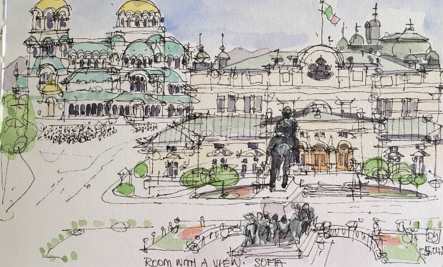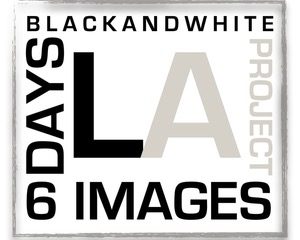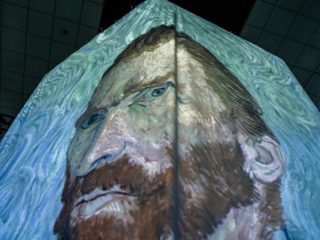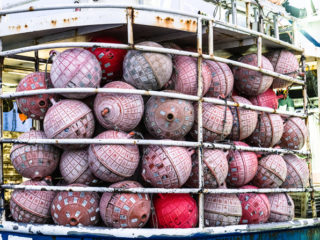KAISER’S DOME
Hilton Hawaiian, Waikiki
The Geodesic Dome Auditorium in Henry J. Kaiser’s Hawaiian Village was put up in less than 36 hours. Work was begun at 7:00 am on Saturday, January 12, 1957 and at 6:00 pm on Sunday, January 15, the aluminum exterior shell of the dome was complete.
Workmen erected the dome in two 11-hour shifts on Saturday and Sunday. Before work began on Saturday, 25 concrete foundation piers were poured, and a temporary central construction mast was set up. The first panels of the dome were assembled around the construction mast, using vise-grip clamps to hold them in place for Huck-bolting (a rivet-like, permanent fastener that must be cut off for disassembly).
Four hand-operated winches at the base of the mast raised the first assembled ring of aluminum sections, and subsequent rows of panels were fitted to the outer edge of the roof assembly. As each ring of panels was completed, the dome was cranked higher.
By 6:00 pm on Sunday, the last ring was finished, and the dome was lowered onto its foundations. Although five days were allocated, the crew took advantage of low winds (unmoored, the dome could become a giant frisbee) and began ahead of schedule.
They finished before Henry Kaiser was able to fly out from California to see it being built. Despite missing the action, he was proud of the workers and commented, “Why those dirty pups, they did it without me.”
The Geodesic Dome Auditorium was manufactured at the Kaiser Aluminum facility in Oakland, California. The 575 aluminum panels varied in length from 106 to 140 inches and in width from 65 to 82 inches. They were marked for assembly and sent to Honolulu.
Each panel was stiffened by six bends (folds) that radiated from each end of the panel and an aluminum strut that bridged the panel across its width. Each diamond-shaped panel had a ¾” flange along its outer edges to help stiffen it and to allow it to be fixed to other panels along its four sides with rivet-like Huck bolts.
At the points where six panels met, star-shaped castings connected them. A strut of 2½-inch pipe connected each of the concrete foundation piers to the star-shaped casting above it.
The bottom tip of each base panel was placed in a short track on each pier to prevent rotary movement. The tracks and the pinned connections at the base of the struts allowed for the dome’s expansion and contraction (as much as three inches) due to temperature changes.
The dome at the Hawaiian Village was the first of Kaiser Aluminum’s domes to be built. Designed by R. Buckminster Fuller, the Honolulu Geodesic Dome was 144 feet in diameter, 48 feet high, and weighed only 39,000 pounds. The Geodesic Dome covered 18,000 square feet of floor space and cost $80,000. Its exterior was painted with dull aluminum paint to minimize glare.
On the second day of construction, so many onlookers gathered that they spilled out of the Hawaiian Village’s vacant lot onto Kalia Road, and police had to direct traffic.
The Geodesic Dome Auditorium was the first that Kaiser was licensed to mass produce from Fuller’s original design, and it was the first of numerous Fuller-designed, Kaiser-manufactured 145 foot and 200-foot diameter domes to be erected during the late 1950s.
The geodesic dome design was originated by R. Buckminster Fuller during the late 1940s from his original work in spherical geometry. Fuller developed the principle of constructing a tensioned framework of members that each describe a great circle, or circumferential slice of a sphere.
Fuller’s work with geodesic domes resulted in an exploration of new forms of architecture that utilized lighter-weight materials in a less massive building.
By 1957 Kaiser Aluminum had contracted with Fuller to mass produce and market geodesic domes of hisdesign. The 145- and 200-foot diameter domes were produced by Kaiser Aluminum in the late 1950s and early 1960s.
The Geodesic Dome Auditorium in Honolulu was the first of either model erected in the United States. After Honolulu’s dome, Kaiser domes went up in Oklahoma City (1958) for the Citizens State Bank, in Moscow (1959) at the U.S. Trade and Cultural Fair, in Fort Worth as a theatre, and in Virginia Beach as a municipal auditorium.
After the dome was built, its shape generated a controversy over what the acoustics would be like during a performance. Henry Kaiser held a press conference in the dome in February, before the official opening.
The Honolulu Advertiser reported: “The aluminum dome’s acoustics are so good it is hard to hear anyone next to you when the loudspeakers are on.” The same article noted Kaiser’s answer to one reporter’s question about rain: “I’ve been in here when it rains and you can’t even hear it.”
After the official opening, which featured the Honolulu Symphony Orchestra, the Advertiser’s William Davenport reported, “The predicted argument about acoustics is already in progress.”
He claimed the amount of echo depended on where one sat. “I sat just about dead center and it sounded fine to me.” Davenport’s impression of a rain shower that came at the end of the program was as different from Kaiser’s as could be. Davenport wrote that the rain sounded “like knives stabbing a drum.”
The Geodesic Dome Auditorium was controversial even before it was built. In September 1956, aluminum was not included as a structural material in Honolulu’s Uniform Building Code. But, in October 1956, the board of supervisors authorized a variance from the UBC to allow Kaiser to build his dome.
Many famous musicians, including Arthur Lyman and Don Ho, performed and even recorded in the dome. The dome was demolished in 1999 to make way for the Kalia Tower, which opened in 2001.
Historical research by Katie Stephen, AIA
















